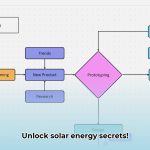Harness the sun’s power and reduce your carbon footprint! This comprehensive guide provides actionable strategies for efficient solar panel installation, optimized energy usage, and long-term system maintenance. Learn how to assess your property’s solar potential, select the right components, streamline the installation process, and maximize your return on investment. Learn more about solar energy storage options.
Evaluating Your Home’s Solar Potential
Before investing in solar panels, determine if your property is suitable for solar energy generation. Key considerations include:
Roof Orientation and Sunlight Exposure
In the Northern Hemisphere, south-facing roofs receive the most sunlight throughout the day, maximizing energy production. Evaluate your roof’s orientation using a compass or online mapping tools. Aim for minimal shading from trees, chimneys, or adjacent buildings. Even partial shading can significantly reduce solar panel output.
- Tip: Trim overgrown trees or relocate obstructions to optimize sunlight exposure.
Roof Condition and Angle
Inspect your roof for any signs of damage, such as leaks, missing shingles, or structural issues. Address these problems before installing solar panels to avoid costly repairs later. The ideal roof angle for solar panels depends on your latitude and climate. A steeper angle is generally better for winter months when the sun is lower in the sky, while a shallower angle is more suitable for summer months.
- Fact: According to the National Renewable Energy Laboratory (NREL), solar panels perform best at a tilt angle equal to your latitude.
Local Regulations and Permits
Research local zoning regulations, building codes, and homeowners association (HOA) rules regarding solar panel installations. Obtain necessary permits before starting the installation process to avoid fines or delays.
Selecting the Right Solar Components
Choosing the right solar components is essential for efficient energy generation and long-term system performance. Key components include:
Solar Panels
Different types of solar panels offer varying levels of efficiency, cost, and durability. Consider the following options:
- Monocrystalline Panels: Made from single-crystal silicon, monocrystalline panels are the most efficient and durable, but also the most expensive.
- Polycrystalline Panels: Made from multiple silicon crystals, polycrystalline panels are less efficient than monocrystalline panels but more affordable.
-
Thin-Film Panels: Made from thin layers of semiconductor material, thin-film panels are flexible, lightweight, and cost-effective, but less efficient and durable than crystalline panels.
-
Recommendation: For optimal efficiency and longevity, invest in monocrystalline panels if your budget allows.
Inverters
Inverters convert the DC electricity generated by solar panels into AC electricity that can be used to power your home. Different types of inverters include:
- String Inverters: Connect multiple solar panels in a series, sending DC electricity to a central inverter. String inverters are the most affordable option, but the performance of the entire string is limited by the weakest panel.
- Microinverters: Attached to each individual solar panel, microinverters convert DC electricity into AC electricity at the source. Microinverters optimize the performance of each panel independently, maximizing energy production and allowing for individual panel monitoring.
-
Power Optimizers: Similar to microinverters, power optimizers are attached to each solar panel and optimize its performance. However, power optimizers still require a central inverter to convert DC electricity into AC electricity.
-
Strategic Choice: Microinverters or power optimizers are ideal for roofs with shading issues or complex orientations as they maximize energy production.
Batteries
Batteries store excess solar energy for use when the sun isn’t shining, providing backup power during outages and reducing reliance on the grid.
- Lithium-Ion Batteries: The most popular choice for solar energy storage due to their high energy density, long lifespan, and fast charging capabilities.
-
Lead-Acid Batteries: A more affordable option, but lead-acid batteries have a shorter lifespan and lower energy density than lithium-ion batteries.
-
Note: Battery sizing depends on your energy consumption patterns and backup power requirements.
Streamlining the Solar Panel Installation Process
A professional solar panel installation ensures safety, efficiency, and compliance with local regulations.
Hiring a Qualified Installer
Choose a licensed and insured solar installer with a proven track record of successful installations. Obtain multiple quotes and compare pricing, warranties, and customer reviews.
- Tip: Check the installer’s certifications from organizations like the North American Board of Certified Energy Practitioners (NABCEP).
System Design and Permitting
Work with your installer to design a solar panel system that meets your energy needs and budget. The installer will handle the permitting process, ensuring compliance with local regulations and building codes.
Installation and Inspection
The installation process typically takes a few days, depending on the size and complexity of the system. Once the installation is complete, a local inspector will verify that the system meets safety and code requirements.
Maximizing Your Solar Investment
Optimize your solar investment by implementing energy-efficient practices and taking advantage of available incentives.
Energy Efficiency Measures
Reduce your energy consumption by:
- Replacing old appliances with Energy Star-certified models.
- Insulating your home to reduce heating and cooling costs.
- Using LED lighting throughout your home.
- Installing a smart thermostat to optimize energy usage.
Incentives and Rebates
Take advantage of federal, state, and local incentives, rebates, and tax credits to reduce the cost of your solar panel system.
- Federal Investment Tax Credit (ITC): Offers a significant tax credit for homeowners who install solar panels.
-
State and Local Incentives: Many states and local governments offer additional incentives and rebates for solar energy systems.
-
Resource: Consult the Database of State Incentives for Renewables & Efficiency (DSIRE) for detailed information on available incentives in your area.
Net Metering
Net metering is a billing system that credits you for excess solar energy that you send back to the grid. This allows you to offset your electricity bill and potentially earn income from your solar panel system.
Maintaining Your Solar Panel System
Regular maintenance ensures optimal performance and extends the lifespan of your solar panel system.
Cleaning Solar Panels
Clean your solar panels regularly to remove dirt, dust, and debris that can reduce energy production. Use a soft brush and water to clean the panels, avoiding harsh chemicals or abrasive cleaners.
- Frequency: Clean your solar panels every six months, or more frequently in dusty environments.
Monitoring System Performance
Monitor your solar panel system’s performance regularly to identify any potential issues. Most inverters and monitoring systems provide data on energy production, grid feed-in, and system status.
Professional Inspections
Schedule professional inspections every few years to identify and address any potential problems with your solar panel system. A qualified technician can inspect the panels, inverters, wiring, and other components to ensure optimal performance and safety.
By following these guidelines, you can harness the power of the sun, reduce your carbon footprint, and save money on your electricity bill. Embracing solar energy is a smart investment for your home and the environment.
- Choosing the Right Portable Hydro Turbine for Your Needs - December 14, 2025
- Best Portable Hydro Generators for Off-Grid and Outdoor Power - December 13, 2025
- Choosing the Right Generator with Water for Off-Grid Power - December 12, 2025
















